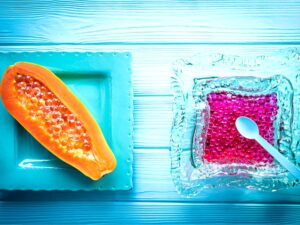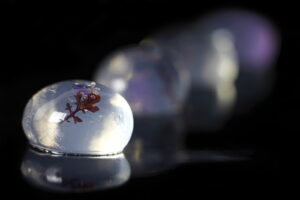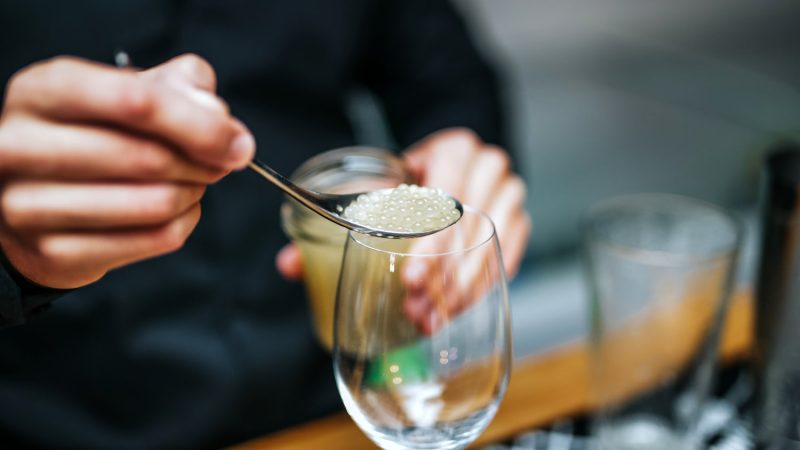Molecular gastronomy is a mix of cooking and science. It uses scientific experimentation to break down food into its simplest parts, only to put it back together in new and surprising ways.
Chefs are those who can find the right balance between flavor and art but don’t forget the showmanship that comes with this type of cooking. The main idea is to look for new ways to cook food, and to do this, it is needed to take a scientific approach.
There are many different ways to use molecular gastronomy to make food that tastes good in new ways. Some of the most common molecular gastronomy methods are spherification, gelification, emulsification, process, and sous-vide.
Molecular Gastronomy and How it works?
Molecular gastronomy is based on the fact that diverse ingredients interact to produce a wide range of outcomes. Physical, biological, and chemical mechanisms underlie every recipe and ensure that the final product is what the cook intended.
The proteins in egg whites cause a souffle to “inflate” rather than flatten out like a pancake, and this is an example of molecular gastronomy. Here’s how it happens – air bubbles are formed when the egg whites are whisked and they expand when cooked.
Molecular gastronomy not only aims to improve traditional souffle recipes but also to discover new and exciting mechanisms and results altogether.
Creative Methods of Spherification
Molecular gastronomy and the approaches discussed below are not new. However, they are relatively recent when compared to the time-honored methods of cooking that have been practiced for generations prior. The methods we’ll be covering below are quite new and haven’t been in use for very long.
Spherification
When it comes to molecular gastronomy, spherification is arguably one of the most publicized techniques. It’s a terrific way to catch people off guard. You can fool people’s senses with this unique presentation of familiar flavors.
Spheres can be formed from any liquid during the spherification process. The entire sphere may be firm, gel-like. The outside shell is set for a larger sphere (olive-sized), but the liquid remains inside. When eating, this is part of the surprise: your mouth explodes with the sphere.
Make a dark-colored pineapple juice in the shape of an olive. It will resemble an olive, but taste like pineapple! It’s also possible to produce ravioli that tastes like peas.

Component Glue of Alginate and Calcium Ions
Using alginate and calcium is one of the most frequent ways to create these stunning spheres. Alginate is a complex longer molecule derived from seaweeds. Alginates come in a variety of forms, and not all are suitable for spherification.
Creating a gel that is strong enough to form a sphere is necessary. Large, complex molecules tend to form large networks in gels, and these networks act as a sort of glue to keep the liquid in place.
This huge molecule is alginate. Alginates are big polysaccharides made up of a lengthy chain of two distinct molecules (mannuronic & guluronic acid). While the lengthy chain of molecules on its own can’t create a gel, it does need some sort of structure to keep the liquid in place.
The calcium ions come into play here. Stabilizing two chains of alginate molecules is made possible by these calcium ions sitting in between them.
Alginate and calcium operate like 2-component glue. The glue only works when the two components come together. Nothing will happen as long as they remain separate from one another.
Assembling the Two
Both components are dissolved in water to accomplish this. For example, pineapple juice is mixed with one of the two and dissolved in water, which is then used to make a water bath for dissolving.
Spheres are formed in a water bath by dripping balls of the liquid that need to be made into a sphere. An interaction occurs between the liquid’s outer layer of alginate or calcium ions and those in the water bath. A layer of gel will then grow around your sphere.
Inverse Spherification and Basic Spherification
To construct a sphere out of a substance, you may be puzzled about the component to dissolve in water and which to add. In reality, the choice is up to you based on the desired sphere structure and the material you choose.
For this method to function, the alginate and calcium must not ‘meet’ before creating the spheres. To avoid the spherification process, don’t add alginate to your combination if you have a product that is high in calcium (e.g. milk). Rather, you should prepare an alginate bath.
You should also consider the type of spheres you’re aiming for in addition to interactions with other items in your meal. Since the gel layer is formed by the alginate molecule, the phase containing alginate will result in a gel. If the alginate is dissolved in water, a gel layer will form surrounding the components. Reverse spherification is the technical term for this process.
In contrast, if alginate is present in your product (such as pineapple juice), it will create a gel within the juice. In this case, there will be no outer layer of juice. Adding alginate to the components and generating a calcium water bath generally results in a more delicate sphere.

Insights on Spherification
This recipe does not work well with all liquids. As an example, if your liquid is overly acidic, the balls won’t form properly. To counteract this, you can add sodium citrate to your sodium alginate solution to lower its acidity. Too much sodium citrate may alter the flavor of your final product because it’s both tart and salty.
With SmartWhip, you can create culinary masterpieces! Enhance the eating experience with a unique twist to recipes.
Molecular Gastronomy Techniques
The following is a list of additional popular molecular gastronomy techniques.
Emulsification
Using a hand blender, combine for example soy lecithin with your selected ingredient to make light foams or “airs” that dissolve in the mouth. Foam up mozzarella and tomato slices with tangy balsamic “air” and garnish your cocktail with citrus “air.”
Transglutaminase for Meat Glueing
Glue or transglutaminase is an enzyme commonly used to bond meat, chicken, or fish fillets together. It can also be used to combine several sorts of meats seamlessly. Make spirals out of bacon or arrange different kinds of fish in striped, checked, or other patterns.
Gelification
Liquids and liquified foods can be turned into gels using agents like agar or carrageenan. Create noodles or other interesting shapes for a dessert or an appetizer using this technique.
Sous Vide
When food is vacuum-sealed and then cooked at the correct temperature, it’s called sous vide. Everything from steak to strawberries can be prepared.
Making Powder from Liquids
Maltodextrin, a starch-like material, can be used to powder high-fat drinks. Add a salty or sweet note to any recipe with powdered caramel, coconut oil, Nutella, peanut butter, and more.
Smoking
You can use a smoking pistol to smoke everything from cocktails and beer to sauces and meat. This approach leaves an aromatic flavor and a brief yet appealing presentation of smoke on the plate when used.
Flash Freezing
You can instantly freeze food with liquid nitrogen. There are no huge ice crystals created by this fast method, which preserves food texture. Intricate garnishes and decorations can be created by freezing portions of your dish and then thawing them out quickly.
Experimenting with this science can be a gratifying endeavor that will take your cooking to the next level. Check out the Smartwhip cream chargers to know more.
FAQ
Are foods prepared through molecular gastronomy safe?
Molecular gastronomy, in general, is deemed harmless, provided it is done in moderation and with caution. Added variables include the types of ingredients that are used. Examples of naturally occurring thickeners are gelatin and agar, both of which are safe for consumption.
The mixture gels as the sodium alginate dissolve in the preparation. Why? What can you do to prevent this?
When alginate molecules and calcium ions come in contact, the gelation process begins.
A solid gel is formed when sodium alginate interacts with calcium. A modest amount of calcium can cause sodium alginate to gel when it comes in contact with water. In such cases, use distilled water. This can also happen as a result of reverse spherification.
For a good spherification formula, what are the most important factors?
When it comes to molecular gastronomy, patience and a lot of trial and error are necessary. When using spherification, three critical factors need to be monitored: the pH of the ingredients (too much acidity can prevent spherification, but this can be calibrated), the calcium concentration in the ingredients (too much calcium can also stop the process), and the amount of water that is available (ingredients with too little water cannot be spherified).
What is frozen reverse spherification?
An additional step is added to reverse spherification to achieve this effect: freezing. Freezing solutions provide better control over the final shape and eliminate some limitations of spherification. This is the only method of liquid spherification that allows the use of clearer and/or more acidic liquids, such as alcoholic beverages or lemon juice.

